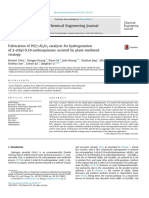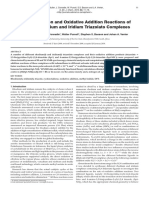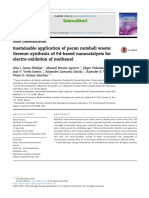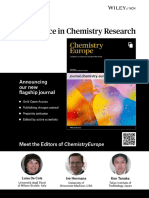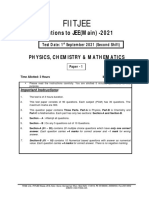Aldehido Si
Aldehido Si
Uploaded by
elkinmateoflorezCopyright:
Available Formats
Aldehido Si
Aldehido Si
Uploaded by
elkinmateoflorezOriginal Title
Copyright
Available Formats
Share this document
Did you find this document useful?
Is this content inappropriate?
Copyright:
Available Formats
Aldehido Si
Aldehido Si
Uploaded by
elkinmateoflorezCopyright:
Available Formats
One-Pot Reductive Mono-N-alkylation of Aniline Cu(PPh3)2BH4 with NH2SO3H,2 thiourea with Hantzsch ester,7,8
and Nitroarene Derivatives Using Aldehydes amino borane derivatives with NaBH4,9 triazole-derived iridium-
(I) carbine complexes,10 and [Ir(cod)2]BF4.11 These methods
have some drawbacks in one way or another such as prolonged
Eunyoung Byun, Bomi Hong, Kathlia A. De Castro, reaction time, acidic conditions, higher reaction temperature,
Minkyung Lim, and Hakjune Rhee*
excess amount of reagents, inert conditions, and toxic byprod-
Hanyang UniVersity, Department of Chemistry and Applied ucts. Thus, it is necessary to develop an alternative method that
Chemistry Ansan Sangrok-Gu Sa-3-Dong 1271, employs simple and mild as well as environmentally benign
Kyunggi-Do 426-791, Korea conditions. In addition, there is also a growing specific interest
in developing controlled synthesis of secondary amines due to
hrhee@hanyang.ac.kr its vast applications. Traditional methodologies for secondary
amines are often problematic because of harsh reaction condi-
ReceiVed July 19, 2007 tions, overalkylation, low chemical selectivity, and generally
poor yields.12 Recently, the use of nitrile13,14 as alkylating agent
was published as an alternative. Herein, we report an efficient,
facile, mild, and environmentally benign one-pot reductive
mono-N-alkylation of aniline and nitroarene derivatives using
aldehydes by Pd/C catalyst in aqueous alcoholic solvents with
ammonium formate as in situ hydrogen donor.
This investigation started from our curiosity in the reductive
amination of ketone using Pd/C catalyst and formate salts.15
One-pot reductive mono-N-alkylation of aniline and ni- We wondered if this condition worked with aldehydes but to
troarene derivatives using various aldehydes by Pd/C catalyst our surprise, when we performed a test reaction using benzal-
in aqueous 2-propanol solvent with ammonium formate as dehyde, the reaction failed to proceed. Thus, we hypothesized
in situ hydrogen donor is illustrated. The reaction proceeded that ammonium formate is a nonparticipant in the amination
smoothly and selectively with excellent yield at room process and that it acts as an in situ hydrogen donor for
temperature. Our protocol presents a facile, economical, and heterogeneous catalytic hydrogenation. In fact, there have been
environmentally benign alternative for reductive amination. numerous reports on the versatility of ammonium formate as
agent in catalytic hydrogen transfer reactions.16 Consequently,
we decided to prove this hypothesis and find appropriate
Amines and their derivatives are highly versatile building conditions for the reductive amination of aldehydes.
blocks for various organic substrates and are essential precursors Initially, we checked for suitable solvent using aniline and
to a variety of biologically active compounds. It has unique acetaldehyde as our test reaction as shown in Scheme 1. We
biological properties that make it a useful target for various found that 2-propanol/water (10:1, v/v) would give the best yield
therapeutic applications.1 Amines also serve other purposes in without dialkylation product (Table 1).
the fields of bioorganic, industrial, and synthetic organic
chemistry.2 With this growing repertoire of applications, SCHEME 1
developing efficient methods for the synthesis of amines draws
much attention.
Direct reductive amination of aldehydes and ketones is one
of the most attractive methods for the synthesis of amine
derivatives. This is particularly advantageous because the Using the same test reaction and the chosen solvent system,
carbonyl compound and the amine with the appropriate reducing we checked the optimum amount of catalyst (Pd/C) and
agent are treated in a one-pot fashion such that isolating the ammonium formate necessary to affect reductive amination
imine intermediate is avoided. There have been many reagents (Table 2). Various types of aldehydes were reacted with aniline
developed recently to effect reductive amination of carbonyls. using this protocol to evaluate its general applicability.
These include the following: LiClO4-zirconium borohydride
piperazine complexes,3 H3PW12O40-NaBH4,4 NaBH(OAc)3,5 (7) Menche, D.; Arikan, F. Synlett 2006, 6, 841.
(8) Menche, D.; Bohm, S.; Li, J.; Rudolph, S.; Zander, W. Tetrahedron
Ph2SiH2, or PhSiH3 with catalytic Bu2SnClH-pyridine N-oxide,6 Lett. 2007, 48, 365.
(9) Suginome, M.; Tanaka, Y.; Hasui, T. Synlett 2006, 7, 1047.
* To whom correspondence should be addressed. Fax: 82-31-407-3863. (10) Gnanamgari, D.; Moores, A.; Rajaseelan, E.; Crabtree, R. H.
(1) Bradshaw, J. S.; Krakowisk, K. E.; Izatt, R. H. Tetrahedron 1992, Organometallics 2007, 26, 1226.
22, 4475. (11) Imao, D.; Fujihara, S.; Yamamoto, T.; Ohta, T.; Ito, Y. Tetrahedron
(2) Bhanushali, M. J.; Nandurkar, N. S.; Bhor, M. D.; Bhanage, B. M. 2005, 61, 6988.
Tetrahedron Lett. 2007, 48, 1273. (12) Salvatore, R. N.; Yoon, C. H.; Jung, K. W. Tetrahedron 2001, 57,
(3) Heydari, A.; Khaksar, S.; Esfandyari, M.; Tajbakhsh, M. Tetrahedron 7785.
2007, 63, 3363. (13) Sajiki, H.; Ikawa, T.; Hirota, K. Org. Lett. 2004, 6, 4977.
(4) Heydari, A.; Khaksar, S.; Akbari, J.; Esfandyari, M.; Pourayoubi, (14) Nacario, R.; Kotakonda, S.; Fouchard, D. M. D.; Tillekerante, L.
M.; Tajbakhsh, M. Tetrahedron Lett. 2007, 48, 1135. M. V.; Hudson, R. A. Org. Lett. 2005, 7, 471.
(5) Abdel-Magid, A. F.; Carson, K. G.; Harris, B. D.; Maryanoff, C. A.; (15) Berdini, V.; Cesta, M. C.; Curti, R.; D’Anniballe, G.; Di Bello, N.;
Shah, R. D. J. Org. Chem. 1996, 61, 3849. Nano, G.; Nicolini, L.; Topai, A.; Allegretti, M. Tetrahedron 2002, 58,
(6) Kato, H.; Shibata, I.; Yasaka, Y.; Tsumoi, S.; Yasuda, M.; Baba, A. 5669.
Chem. Commun. 2006, 4189. (16) Ram, S.; Ehrenkaufer, R. E. Synthesis 1998, 2, 91.
10.1021/jo701503q CCC: $37.00 © 2007 American Chemical Society
Published on Web 11/13/2007 J. Org. Chem. 2007, 72, 9815-9817 9815
TABLE 1. Solvent Effect in One-Pot Reductive Amination of SCHEME 2. Presumed Mechanism
Acetaldehyde with Anilinea
yield (%)
reaction N-ethyl- N,N-diethyl-
entry solvent time (min) aniline aniline
1 MeOH 10 85 3
2 EtOH 10 no reactionb
3 i-PrOH 10 no reactionb
4 MeOH/H2Oc 10 83
5 EtOH/H2Oc 10 85
6 i-PrOH/H2Oc 10 91
a Used 0.1 equiv of Pd/C and 10 equiv of ammonium formate.15
b Ammonium formate does not dissolved in EtOH and i-PrOH. c 10:1, v/v.
TABLE 4. One-Pot Reductive Amination of Various Aniline
Derivatives with Butyraldehydea
TABLE 2. Optimization of Pd/C and Ammonium Formate Ratio
ammonium reaction
Pd/C formate time
entry solvent (equiv) (equiv) (min) yield (%)
1 i-PrOH/H2O 0.1 1 120 intractable
(10:1, v/v) mixture
2 0.1 5 10 91
3 0.1 10 10 92
4 0.05 10 60 90
5 0.005 10 120 intractable
mixture
TABLE 3. One-pot Reductive Amination of Various Aldehydes
with Aniline
a The reaction time is 60 min. b Used 10 equiv of ammonium formate.
c Used 10 equiv of aldehyde.
linear (entries 2-4, 8) or R- (entry 6) or â-branched (entry 7)
and cyclic (entries 9 and 10) reacted with the same effectiveness.
On the basis of our presumed mechanism (Scheme 2), aliphatic
and cyclic aldehydes gave excellent yield because the imine
intermediate formed is unstable; thus, it was readily converted
to product by hydrogenation. On the other hand, probably the
imine intermediate formed from the reaction of aromatic
aldehyde is stable, and thus, the backward reaction from the
imine formed might compete with hydrogenation leading to a
decreased in yield.
We further validated the reaction conditions by considering
a Reaction time is 10 min. b In methanol and water solvent. c Used 10
the reaction of various aniline derivatives with butyraldehyde
equiv of ammonium formate. d The reaction was carried out using premixing
method ensuring the formation of imine first; otherwise, the yield would
(Table 4). Mono-N-alkylation of aniline derivatives bearing
be very low (37% for entry 13 and 10% for entry 14) having several electron-donating groups (entries 1-6, 11) at the aromatic ring
byproducts such as dialkylated amine, alcohol, and starting aniline. proceeded smoothly and selectively to the corresponding mono-
N-alkylated aniline derivatives. The same observations hold with
The Pd/C-catalyzed reductive mono-N-alkylation of aniline electron-withdrawing groups at the aromatic ring with some
using various aldehydes was summarized in Table 3. Equimolar exceptions. The aniline having trifluoromethyl (entry 8) and ester
amount of aldehyde and aniline was reacted at room temperature (entry10) substituents gave only 54 and 80% yield having 43
for 30 min using 0.1 equiv of Pd/C catalyst with 5 equiv of and 14% starting aniline, respectively. It is noteworthy that
ammonium formate in 2-propanol/water (10:1, v/v) solvent reducible functional groups such as COOH and COOEt survived
system. Excellent yields of monoalkylation product were with this protocol.
obtained except for the cases of formaldehyde (entry 1) and There have been reports on the reduction of nitro compounds
aromatic aldehydes (entries 12-14). They gave lower yields to their corresponding derivatives using ammonium formate as
with either starting aniline or alcohol (reduced aldehydes) as catalytic hydrogen transfer agent.17 Considering this idea, we
byproduct. Aliphatic aldehydes regardless of whether they are thought that by increasing the amount of ammonium formate
9816 J. Org. Chem., Vol. 72, No. 25, 2007
TABLE 5. One-Pot Reductive Amination of Various Aldehydes TABLE 6. One-Pot Reductive Amination of Various Nitroarene
with Nitrobenzenea Derivatives with Butyraldehydea
a The reaction was carried out with 10 equiv of ammonium formate for
10 min. b Used 12 equiv of ammonium formate; reaction time: 40 min.
a The reaction was carried out with 10 equiv of ammonium formate for
60 min. b Used 15 equiv of ammonium formate. c Used 20 equiv of
we could first reduce the nitro to an amino group in situ and ammonium formate. d Used 10 equiv of aldehyde.
the reaction would proceed in the same manner as mentioned
above. To corroborate this hypothesis as well as further expand proceeds under neutral and aqueous alcoholic conditions, utilizes
the applicability of our protocol, we investigated mono-N- readily available, inexpensive, stable, and nontoxic ammonium
alkylation of nitrobenzene with various aldehydes (Table 5). formate as the in situ hydrogen donor, and makes use of
The reduction of nitrobenzene to aniline and the mono-N- recyclable Pd/C catalyst. Moreover, our one-pot nitro-reduc-
alkylation occurred smoothly and rapidly (only 10 min), and tion-direct reductive amination sequence is very innovative.
the same observation with the aniline case mentioned above This makes our protocol facile, economical, and environmentally
holds. However, this protocol is not applicable to aromatic benign.
aldehydes. Our test reaction using benzaldehyde did not give
Experimental Section
favorable results.
Given that the mono-N-alkylation of nitrobenzene proceeded General Procedure. 2-Propanol (20 mL) was added to a flask
smoothly, we explored the applicability of this protocol to mono- containing Pd/C (0.293 g, 0.275 mmol). Ammonium formate (0.867
N-alkylation of various nitrobenzene derivatives using butyral- g, 13.75 mmol or 1.74 g, 27.5 mmol) dissolved in water (2 mL)
was transferred to the same flask. The reaction mixture was stirred
dehyde (Table 6). Just like the case of aniline derivatives, mono-
for 1 min to activate Pd/C. Next, primary amine or nitro compounds
N-alkylation of nitroarene derivatives bearing electron-donating (2.75 mmol) and aldehyde (2.75 mmol) were added, and the reaction
groups (entries 1-6, 11) at the aromatic ring proceeded mixture was stirred at room temperature (10-30 min or 60 min).
smoothly and selectively to the corresponding mono-N-alkylated After completion of the reaction based on TLC monitoring, the
aniline derivatives. However, those having electron-withdrawing Pd/C catalyst was filtered off on Celite and the solvent was removed
groups at the aromatic ring (entries 8-10) gave unsatisfactory by rotary evaporation. The reaction mixture was diluted with CH2-
results having the aniline derivative as byproduct with the Cl2 and washed with brine solution. The organic phase was
exception of fluorine at the para position (entry 7). Nevertheless, collected, dried with anhydrous MgSO4, and concentrated by rotary
it is again noteworthy that reducible functional groups such as evaporation. The residue was purified by silica gel column
COOH and COOEt survived with this protocol even though an chromatography with an appropriate solvent system.
excess amount of ammonium formate was used. Indeed, it is Acknowledgment. E.B., K.D.C., and M.L. acknowledge
plausible to achieve mono-N-alkylaniline via a one-pot process financial support from the Korean Ministry of Education through
without the separation of aniline intermediate. the second stage of the BK21 project for the Hanyang University
Furthermore, we also checked the reusability of Pd/C catalyst. graduate program, and M.L. also acknowledges Seoul Metro-
We filtered and washed it with water and 2-propanol and directly politan Government for Seoul Science Fellowship.
reused it. The yield did not change even after 10 recycles.
In summary, we have investigated and presented a valuable Supporting Information Available: Detailed experimental
alternative for one-pot reductive amination. Our protocol procedure and compound characterization. This material is available
free of charge via the Internet at http://pubs.acs.org.
(17) Ram, S.; Ehrenkaufer, R. E. Tetrahedron Lett. 1984, 25, 3415. JO701503Q
J. Org. Chem, Vol. 72, No. 25, 2007 9817
You might also like
- Reductive Methylation of Primary and Secondary Amines and Amino Acids by Aqueous Formaldehyde and Zinc100% (2)Reductive Methylation of Primary and Secondary Amines and Amino Acids by Aqueous Formaldehyde and Zinc3 pages
- Acid-Catalyzed Solvent-Free Synthesis of 2-Arylbenzimidazoles Under MW J Mol Cat 2007No ratings yetAcid-Catalyzed Solvent-Free Synthesis of 2-Arylbenzimidazoles Under MW J Mol Cat 20074 pages
- Solvent-Free Reductive Amination: An Organic Chemistry ExperimentNo ratings yetSolvent-Free Reductive Amination: An Organic Chemistry Experiment3 pages
- Org. Lett. 2008, 10, 2075. A Facile Preparation of Imidazolinium ChloridesNo ratings yetOrg. Lett. 2008, 10, 2075. A Facile Preparation of Imidazolinium Chlorides3 pages
- An Efficient One-Pot Strategies For The Synthesis of (1,3) Oxazine DerivativesNo ratings yetAn Efficient One-Pot Strategies For The Synthesis of (1,3) Oxazine Derivatives6 pages
- Solvent Free Green Synthesis of 5-Arylidine Barbituric Acid Derivatives Catalyzed by Copper Oxide NanoparticlesNo ratings yetSolvent Free Green Synthesis of 5-Arylidine Barbituric Acid Derivatives Catalyzed by Copper Oxide Nanoparticles6 pages
- Maity Et Al-2015-European Journal of Organic ChemistryNo ratings yetMaity Et Al-2015-European Journal of Organic Chemistry8 pages
- Ecofriendly Iodination of Activated Aromatics and Coumarins Using Potassium Iodide and Ammonium PeroxodisulfateNo ratings yetEcofriendly Iodination of Activated Aromatics and Coumarins Using Potassium Iodide and Ammonium Peroxodisulfate6 pages
- Spectrochimica Acta A: Molecular and Biomolecular SpectrosNo ratings yetSpectrochimica Acta A: Molecular and Biomolecular Spectros10 pages
- Ring Opening of Epoxides With Sodium Azide in Water. A Regioselective pH-Controlled ReactionNo ratings yetRing Opening of Epoxides With Sodium Azide in Water. A Regioselective pH-Controlled Reaction3 pages
- Basudeb Basu Et Al - A Simple Protocol For Direct Reductive Amination of Aldehydes and Ketones Using Potassium Formate and Catalytic Palladium AcetateNo ratings yetBasudeb Basu Et Al - A Simple Protocol For Direct Reductive Amination of Aldehydes and Ketones Using Potassium Formate and Catalytic Palladium Acetate3 pages
- Recent Developments On Carbon-Carbon Bond Forming Reactions in WaterNo ratings yetRecent Developments On Carbon-Carbon Bond Forming Reactions in Water14 pages
- A Simple One-Step Conversion Carboxylic Acids To Esters UsingNo ratings yetA Simple One-Step Conversion Carboxylic Acids To Esters Using3 pages
- A General Method For C Reductive Alkylation of Indoles: Anu Mahadevan, Howard Sard, Mario Gonzalez and John C. MckewNo ratings yetA General Method For C Reductive Alkylation of Indoles: Anu Mahadevan, Howard Sard, Mario Gonzalez and John C. Mckew3 pages
- A New Method For The Synthesis of Heterocycles FromNo ratings yetA New Method For The Synthesis of Heterocycles From4 pages
- Reductive Amination With Sodium TriacetoxyborohydrideReductive Amination With Sodium Triacetoxyborohydride100% (1)Reductive Amination With Sodium TriacetoxyborohydrideReductive Amination With Sodium Triacetoxyborohydride14 pages
- Characterization and Oxidative Addition Reactions of Different Rhodium and Iridium Triazolato ComplexesNo ratings yetCharacterization and Oxidative Addition Reactions of Different Rhodium and Iridium Triazolato Complexes9 pages
- Ionic Liquids Perspectives For Organic and Catalytic Reactions, Olivier y MagnaNo ratings yetIonic Liquids Perspectives For Organic and Catalytic Reactions, Olivier y Magna19 pages
- ArticA Multistep Synthesis Incorporating A Green Bromination of An Aromatic RinguloNo ratings yetArticA Multistep Synthesis Incorporating A Green Bromination of An Aromatic Ringulo3 pages
- Regioselective Formation of R-Vinylpyrroles From The Ruthenium-Catalyzed Coupling Reaction of Pyrroles and Terminal Alkynes Involving C - H Bond ActivationNo ratings yetRegioselective Formation of R-Vinylpyrroles From The Ruthenium-Catalyzed Coupling Reaction of Pyrroles and Terminal Alkynes Involving C - H Bond Activation3 pages
- Eco-Friendly One Pot Synthesis of Coumarin Derivatives by Pechmann Condensation Using Tamarind Juice As A BiocatalystNo ratings yetEco-Friendly One Pot Synthesis of Coumarin Derivatives by Pechmann Condensation Using Tamarind Juice As A Biocatalyst4 pages
- Research Article: Designer C - Symmetric Chiral Diamide-Type Organoiodine CatalystsNo ratings yetResearch Article: Designer C - Symmetric Chiral Diamide-Type Organoiodine Catalysts13 pages
- Communications: Dehydrogenative CouplingNo ratings yetCommunications: Dehydrogenative Coupling5 pages
- Sustainable synthesis of ciclopentene derivatives through multicomponent reactions in continuous flow regimeFrom EverandSustainable synthesis of ciclopentene derivatives through multicomponent reactions in continuous flow regimeNo ratings yet
- Organic Reaction Mechanisms 1982: An annual survey covering the literature dated December 1981 through November 1982From EverandOrganic Reaction Mechanisms 1982: An annual survey covering the literature dated December 1981 through November 1982A. C. KnipeNo ratings yet
- Iridium Complexes in Organic SynthesisFrom EverandIridium Complexes in Organic SynthesisLuis A. OroNo ratings yet
- Organic Reaction Mechanisms 1981: An annual survey covering the literature dated December 1980 through November 1981From EverandOrganic Reaction Mechanisms 1981: An annual survey covering the literature dated December 1980 through November 1981A. C. KnipeNo ratings yet
- 7 Jee Main 2021 Sep 01 Second Shift PaperNo ratings yet7 Jee Main 2021 Sep 01 Second Shift Paper40 pages
- Isolation and Color Reactions of Intact Protein (Casein)No ratings yetIsolation and Color Reactions of Intact Protein (Casein)3 pages
- Q1 Weeks-5-6 Module-5 Conchem SSElectiveNo ratings yetQ1 Weeks-5-6 Module-5 Conchem SSElective23 pages
- Chapter 3 Biochemistry Lehninger SlidesNo ratings yetChapter 3 Biochemistry Lehninger Slides55 pages
- IMP Qns of Chemistry by Alok Sir 2024-25No ratings yetIMP Qns of Chemistry by Alok Sir 2024-253 pages
- Glutaraldehyde Behavior in Aqueous Solution, Reaction With Proteins, and Application To Enzyme CrosslinkingNo ratings yetGlutaraldehyde Behavior in Aqueous Solution, Reaction With Proteins, and Application To Enzyme Crosslinking12 pages
- Chitosan Chemistry Relevance To The Biomedical Sciences100% (1)Chitosan Chemistry Relevance To The Biomedical Sciences59 pages
- Characterization of Sulfonated Azo Dyes and Aromatic Amines by Pyrolysis Gas Chromatography/mass SpectrometryNo ratings yetCharacterization of Sulfonated Azo Dyes and Aromatic Amines by Pyrolysis Gas Chromatography/mass Spectrometry10 pages
- [FREE PDF sample] Organic Chemistry 12th 12th Edition Francis Carey ebooks100% (3)[FREE PDF sample] Organic Chemistry 12th 12th Edition Francis Carey ebooks57 pages
- CBSE Class 12 Chemistry Syllabus 2024-25 - Revised PDF DownloadNo ratings yetCBSE Class 12 Chemistry Syllabus 2024-25 - Revised PDF Download10 pages
- Organic Name Reactions/Revision List For Top Ranks in IIT/AIIMSNo ratings yetOrganic Name Reactions/Revision List For Top Ranks in IIT/AIIMS54 pages
- It Is "2-Imino-4-Thiazolidinones" and Not Thiohydantoins As The Reaction Product of 1,3-Disubstituted Thioureas and ChloroacetylchlorideNo ratings yetIt Is "2-Imino-4-Thiazolidinones" and Not Thiohydantoins As The Reaction Product of 1,3-Disubstituted Thioureas and Chloroacetylchloride7 pages
- A Analytical Study of Jwara Kesarika Rasa and Its Evaluation of Anti-Bacterial Activity On Salmonella TyphiNo ratings yetA Analytical Study of Jwara Kesarika Rasa and Its Evaluation of Anti-Bacterial Activity On Salmonella Typhi14 pages














